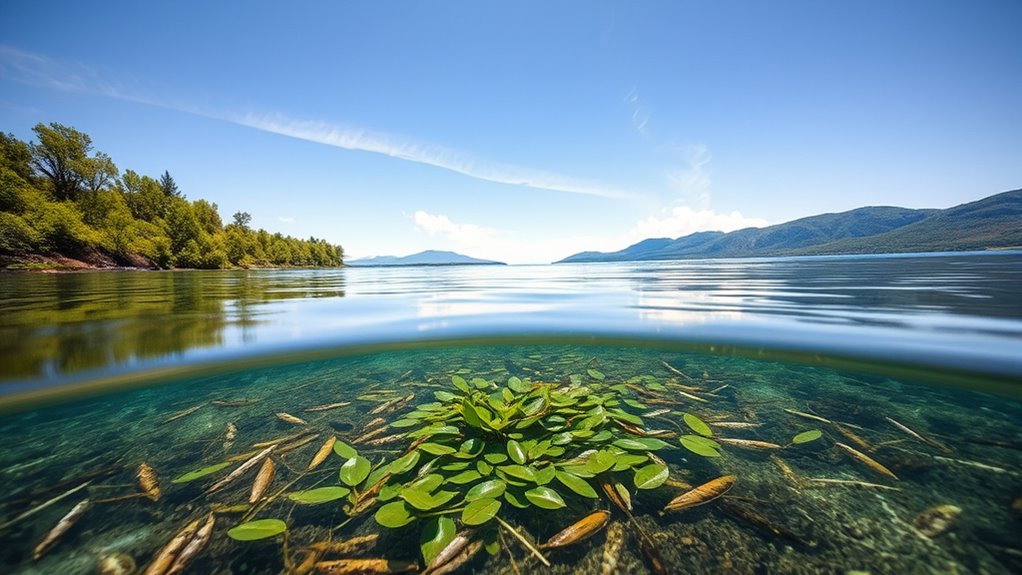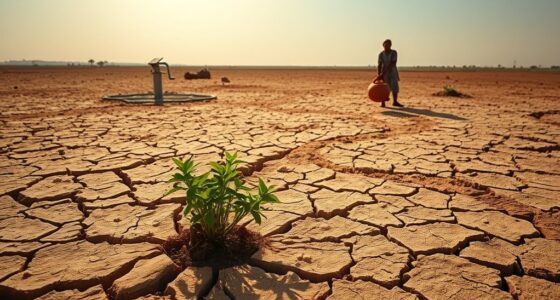The phosphorus cycle is essential for maintaining water quality because it controls nutrient levels that support aquatic life. When excess phosphorus from sources like fertilizers, waste, and runoff enters water bodies, it promotes algae growth, leading to algal blooms and eutrophication. These changes can harm aquatic ecosystems, reduce water clarity, and deplete oxygen. Understanding how phosphorus moves helps you see how human activities impact water health—keep exploring to learn how we can protect these critical systems.
Key Takeaways
- The phosphorus cycle influences water quality by controlling nutrient levels that affect aquatic ecosystems.
- Excess phosphorus from natural and human sources leads to algal blooms and eutrophication.
- Eutrophication depletes oxygen in water, harming aquatic life and causing dead zones.
- Managing phosphorus inputs through responsible farming and waste treatment improves water health.
- Understanding phosphorus movement helps prevent pollution and maintain balanced, clear water bodies.

The phosphorus cycle plays a essential role in maintaining water quality, as this nutrient influences the health of aquatic ecosystems. When phosphorus enters water bodies in excess, it can trigger serious problems like algal blooms and eutrophication. These phenomena disrupt the delicate balance of aquatic life and threaten water usability for drinking, recreation, and industry. Understanding how phosphorus moves through the environment helps you grasp how human activities and natural processes impact water quality.
Phosphorus primarily comes from weathered rocks, soil runoff, fertilizers, and waste. When rain washes over land, it carries phosphorus into lakes, rivers, and ponds. This influx of nutrients fuels the growth of algae, which are usually harmless in small numbers. However, when phosphorus levels become too high, algae multiply rapidly, forming dense mats known as algal blooms. These blooms can produce toxins harmful to aquatic animals, humans, and even plants. As algae die and decompose, oxygen in the water diminishes, creating dead zones where aquatic life struggles to survive.
Rain carries phosphorus into water, fueling algae growth and creating oxygen-depleted dead zones.
Eutrophication is the broader process caused by excess nutrients like phosphorus, leading to excessive plant and algae growth. It accelerates the natural aging process of water bodies, turning clear, healthy lakes into murky, algae-choked environments. This process can take years or decades but is sped up greatly by human activities such as agriculture runoff and wastewater discharge. When phosphorus levels remain high over time, eutrophication becomes a persistent problem, degrading water quality and impairing ecosystems. Recognizing the nutrient cycling process helps explain how phosphorus contributes to these ecological changes.
Your role in managing phosphorus levels is essential. If you’re involved in agriculture, reducing fertilizer use or adopting best practices can limit phosphorus runoff. Proper waste management and wastewater treatment also help prevent excess phosphorus from reaching water bodies. These steps can slow or even reverse eutrophication, allowing aquatic ecosystems to recover and maintaining water clarity and quality.
Understanding the phosphorus cycle empowers you to recognize the importance of controlling nutrient inputs into water systems. Excess phosphorus doesn’t just cause algae to grow out of control; it triggers a chain of ecological consequences that can take years to fix. By staying aware of how human actions influence this cycle, you contribute to protecting water resources and ensuring healthier aquatic environments for everyone. Whether through individual choices or community initiatives, managing phosphorus input is key to preventing algal blooms and maintaining balanced, vibrant water ecosystems.
Frequently Asked Questions
How Does Phosphorus Runoff Specifically Affect Aquatic Ecosystems?
When phosphorus runoff enters aquatic ecosystems, it fuels excessive algal blooms that block sunlight and disrupt normal conditions. This process causes eutrophication, leading to oxygen depletion as algae decay. You might notice fish and other aquatic life struggling or dying due to the lack of oxygen. Ultimately, phosphorus runoff harms water quality, threatens biodiversity, and can make water unsafe for recreation and consumption.
What Are Natural Sources of Phosphorus in Water Bodies?
Imagine a quiet stream nestled among rocky hills, where phosphorus quietly enters the water. Natural sources include geological sources like weathering of phosphate-rich rocks, which releases phosphorus through erosion. Phosphorus mineralization also plays a role, breaking down organic material and releasing phosphates. These processes steadily supply phosphorus to water bodies, maintaining a natural balance that supports aquatic life without causing overgrowth or pollution.
How Can Phosphorus Levels Be Effectively Monitored in Real-Time?
You can effectively monitor phosphorus levels in real-time by using advanced sensor technology that detects phosphorus concentrations continuously. These sensors send data directly to a monitoring system, enabling instant analysis. Incorporate data analytics to interpret the incoming information, identify trends, and detect any spikes. This combination allows you to respond quickly to changes, ensuring water quality remains safe and well-managed.
What Are the Long-Term Impacts of Phosphorus Accumulation in Sediments?
You should know that long-term phosphorus accumulation in sediments can lead to sustained nutrient release, which fuels algae blooms and harms aquatic ecosystems. As sediments store phosphorus over time, they act as a source of nutrient pollution, causing water quality issues even after controlling external inputs. This sediment storage can result in persistent eutrophication, making it difficult to restore water health and requiring ongoing management efforts.
How Does Climate Change Influence the Phosphorus Cycle?
Climate change increases temperatures and alters precipitation patterns, which accelerate phosphorus mobility in aquatic systems. This leads to climate-induced eutrophication, causing excessive algae growth and oxygen depletion. Warmer waters also promote the release of phosphorus from sediments, further fueling nutrient overloads. You’ll see more frequent and severe algal blooms, threatening water quality and aquatic life as climate change intensifies the phosphorus cycle’s impacts on ecosystems.
Conclusion
As you imagine the gentle flow of water through rivers and lakes, remember that phosphorus shapes this journey. When it’s balanced, water sparkles with life; when it’s overwhelming, it chokes under the weight of algae blooms. You hold the power to protect these essential waters—by understanding the cycle and reducing pollution, you help preserve their clarity and vitality. Together, you can keep these waterways vibrant and alive for generations to come.









